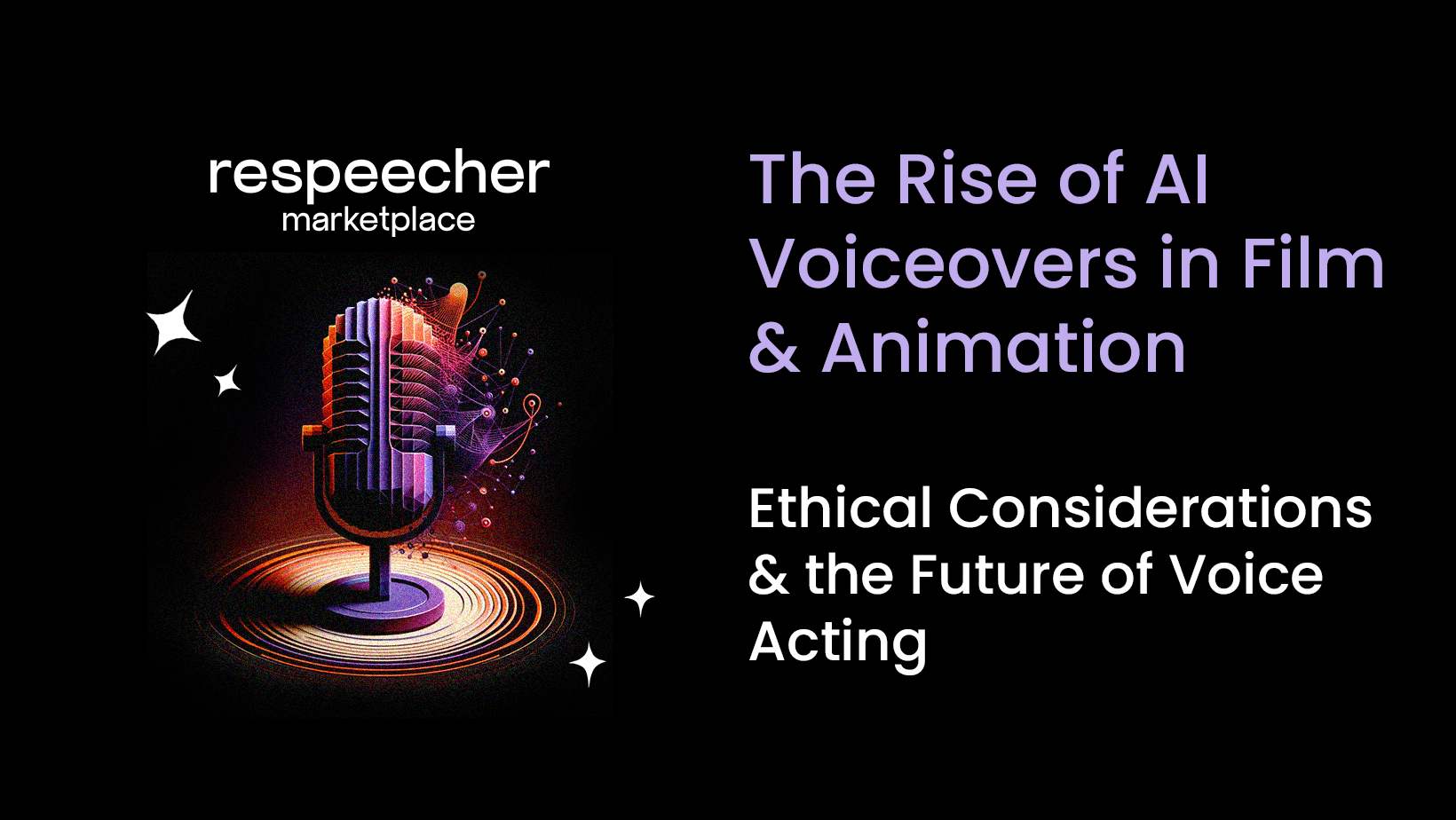The Rise of AI Voiceovers in Film and Animation

Technological advancements continually reshape the film and animation industry landscape, offering new tools and possibilities for creators to captivate audiences. In particular, integrating AI voiceovers marks a pivotal moment in the evolution of storytelling and character portrayal. The film and animation industry has always been a hotbed of innovation, from hand-drawn animations to cutting-edge CGI graphics. The emergence of AI introduces a new dimension, one that revolutionizes how voices are sourced and utilized in productions.
The Advent of AI in Voiceover Production
At the heart of AI voiceover production are voice synthesis and voice cloning technologies that leverage advanced machine learning algorithms to analyze and replicate the nuances of human speech, including intonation, pacing, and emotion.
Voice synthesis takes this a step further by allowing studios to replicate the voices of real people, whether celebrities, historical figures, or anonymous contributors. AI algorithms can analyze and mimic the unique vocal characteristics of a target speaker, producing a synthesized voice that closely resembles the original - with their consent, of course.
This opens up many creative possibilities, from resurrecting iconic voices for archival footage to crafting entirely new characters with distinct personalities and accents.
Advantages for Studios
Adopting AI voiceover technologies offers several compelling advantages for studios and production companies. With AI, studios can generate custom voices on demand tailored to the specific requirements of each project. This flexibility allows for faster turnaround times and greater control over the creative direction of the audio elements.
Furthermore, AI voiceovers can significantly reduce production costs, particularly for projects with tight budgets or extensive voiceover requirements. It extends to localization and dubbing efforts, where AI can swiftly generate translated voice tracks in multiple languages, catering to diverse global audiences.
Advantages for Voice Actors
While AI voiceover technology may raise concerns about the displacement of human talent, it also presents opportunities for voice actors to expand their repertoire and reach new audiences. Rather than replacing human actors outright, AI voice synthesis serves as a complementary tool, enhancing the capabilities of performers and offering new avenues for collaboration.
Voice actors can leverage AI to experiment with different character voices, accents, and styles, allowing them to showcase their versatility and creativity in previously impractical ways. AI voice technology also enables actors to preserve and license their vocal likenesses, creating new revenue streams from endorsements, branded content, and other projects.
Impact of AI Voiceovers on the Film and Animation Industry
Efficiency and Creative Flexibility
AI voiceovers streamline production workflows, offering unparalleled efficiency in generating and editing audio content. Unlike traditional voice recording sessions, which require coordinating schedules and managing logistics, AI allows for on-demand voice generation with minimal lead time. This agility empowers filmmakers and animators to iterate on dialogue, narration, and character performances rapidly, enhancing the overall quality and coherence of the final product. You can read more about how Respeecher Voice Marketplace made this happen in our case study Lost in Time, Found in Sound: Recreating 'Lost in Space's' Child Voices for Scary Robot Productions.
Cost-Effectiveness and Project Flexibility
From a financial standpoint, AI voiceovers can generate translated voice tracks efficiently and affordably, enabling seamless distribution across global markets. AI voiceovers also enhance project flexibility by reducing dependency on external factors such as the voice actor’s schedule.
Impact on Voice Actors and Revenue Generation
For voice actors, AI voiceovers present both challenges and opportunities. While some express concerns about job displacement and industry disruption, others see AI as a valuable tool for expanding their skill set and market reach. Voice banking and scaling technologies allow actors to preserve and monetize their vocal performances, creating new revenue streams from licensing agreements, branded content, and personalized voice assistant applications.
Additionally, AI voiceovers enable voice actors to take on more projects simultaneously, thanks to the efficiency gains and project flexibility afforded by AI technology. This scalability empowers actors to diversify their portfolios, explore niche markets, and collaborate with a broader range of clients and collaborators.
For example, Respeecher helped to restore Darth Vader’s original voice for the Obi-Wan Kenobi series. With machine learning technology, we created a clone of James Earl Jones’s voice, allowing Darth Vader to resume his role as the evil Sith Lord in all his glory. Also, the company created a digital replica of Michael York's voice for a meaningful healthcare project.
Challenges Faced in Implementing AI Voiceovers
While AI voiceovers offer numerous benefits, their implementation presents challenges that filmmakers and animators must navigate. One of the primary concerns is authenticity – ensuring that AI-generated voices convey emotions and nuances convincingly. Historically, synthetic voices have struggled to match the depth and subtlety of human performances, often sounding robotic or monotonous. Overcoming this challenge requires natural language processing and emotional modeling advancements to imbue AI voices with lifelike qualities.
Additionally, maintaining emotional depth poses a significant hurdle for AI voiceovers. Human actors possess the innate ability to convey complex emotions through tone and facial expressions, a feat that AI algorithms must replicate convincingly. Achieving this level of emotional fidelity requires ongoing refinement of AI models and techniques and collaboration between developers and creative professionals to capture the nuances of human expression - which Respеecher has mastered.
While synthetic voices have made significant strides in recent years, some viewers may still perceive them as artificial or disengaging, particularly in emotionally resonant scenes. Bridging this gap between audience expectations and AI capabilities requires careful consideration of context, pacing, and character development to ensure that AI-generated voices resonate with viewers on an emotional level.
Despite these challenges, our synthetic voices convey emotions with remarkable authenticity and depth. Leveraging state-of-the-art emotional modeling algorithms, Respeecher's AI voiceovers capture the subtleties of human expression, enriching storytelling and character interactions in ways that rival traditional voice acting.
Opportunities Provided by AI Voiceovers
AI voiceovers offer many opportunities for filmmakers, animators, and audiences alike. One notable advantage is increased diversity in language options and accessibility. AI technology enables the rapid generation of voice tracks in multiple languages, dialects, and accents, facilitating greater cultural representation and global reach. This diversity enhances the authenticity of storytelling and fosters inclusivity by catering to diverse linguistic communities.
Also, AI voiceovers enhance accessibility for viewers with disabilities, such as visual impairments or language barriers. By providing audio descriptions, subtitles, and alternative language tracks, AI technology ensures that content is accessible to audiences of all backgrounds and abilities. This inclusivity aligns with industry efforts to promote diversity and representation in media, fostering a more inclusive and equitable entertainment landscape.
Ethical Considerations and the Future of Voice Acting
As AI voiceovers continue to gain prominence in the film and animation industry, ethical considerations surrounding their implementation have come to the forefront. One of the primary concerns is the potential impact on traditional voice-acting jobs. The rise of AI technology has sparked debates about job displacement and the future viability of human actors in an increasingly automated landscape.
Recent events, such as the American actors' union SAG-AFTRA strike, underscore the tensions between technological innovation and labor rights within the entertainment industry. Voice actors have raised legitimate concerns about fair compensation, job security, and creative control in the face of AI-driven productions. Additionally, issues of consent arise concerning the use of individuals' voices for synthesis without their explicit permission.
However, it's essential to recognize that AI voiceovers also present opportunities for collaboration and innovation within the industry. Rather than viewing AI as a threat to human talent, some proponents argue that it can complement traditional voice acting, expanding the creative toolkit available to performers and creators alike.
Instead of displacing human actors entirely, AI voiceovers may catalyze a reimagining of the industry, fostering new opportunities for collaboration and specialization. Voice actors may increasingly focus on roles that demand complex emotional expression, authenticity, and cultural nuance, while AI technology handles tasks that require efficiency, scalability, and multilingual capabilities.
Future Trends and Predictions
Integrating AI voiceovers into film and animation heralds a new era of storytelling characterized by unprecedented creativity, accessibility, and immersion. Looking ahead, several trends and predictions emerge regarding how AI voiceovers could shape the future of storytelling in visual media:
- Personalized Narrative Experiences: As AI voice synthesis technology advances, we expect to see a proliferation of customized narrative experiences tailored to individual viewers. AI algorithms will analyze user preferences, demographics, and viewing history to generate customized voiceover tracks, adapting dialogue, pacing, and emotional tone to resonate with each viewer on a deeper level.
- Multilingual and Cross-Cultural Storytelling: AI voiceovers offer unparalleled versatility in language localization and cultural representation, enabling filmmakers to reach global audiences with authenticity and nuance. We may see a rise in multilingual productions that seamlessly integrate diverse voices and perspectives, fostering greater cultural exchange and understanding.
- Dynamic Interactive Narratives: With advancements in AI-driven interactive storytelling, audiences will increasingly participate in shaping narrative outcomes through real-time dialogue interactions with AI characters. This dynamic form of storytelling blurs the lines between viewer and protagonist, empowering audiences to co-create immersive worlds and meaningful experiences.
- Accessibility and Inclusivity: AI voiceovers hold immense potential for enhancing accessibility and inclusivity in media, particularly for individuals with disabilities. By offering synthesized audio descriptions, subtitles, and alternative language tracks, AI technology can ensure that content is accessible to audiences of all backgrounds and abilities, fostering a more inclusive entertainment landscape.
- Augmented Reality and Immersive Experiences: AI voiceovers will enhance augmented reality (AR) and immersive experiences, providing real-time audio guidance, character interactions, and ambient storytelling elements. Whether in location-based entertainment attractions, educational applications, or gaming experiences, AI-driven voiceovers will enrich the sensory landscape and deepen audience engagement.
Conclusion
AI voiceovers have democratized access to high-quality voice performances, empowering filmmakers and animators to realize their creative visions with greater speed, flexibility, and cost-effectiveness. However, amidst the technological advancements and innovations, it's essential to recognize the indispensable role of human creativity in the evolution of entertainment.
While AI voiceovers offer unprecedented efficiency and scalability, they must be complemented by human acting, emotion, and artistic expression to resonate with audiences truly. The Respeecher Voice Marketplace exemplifies this balance between technology and human creativity, providing a platform where AI-driven voiceover solutions coexist with the expertise and craftsmanship of voice actors. Visit the Voice Marketplace today to find out how it can help enhance your projects.
FAQ
AI voiceovers for film and animation utilize AI voice cloning technology to create AI-generated voice performances for characters, enabling cost-effective dubbing and enhancing storytelling through multilingual voiceovers and emotional AI voice modeling.
AI voiceovers enhance AI-enhanced storytelling by providing voice synthesis in film and animation, allowing creators to craft diverse characters and narratives across languages, bringing more cross-cultural podcasting and global reach to their work.
Yes, AI-generated voices can convey emotions through emotional AI voice modeling, capturing subtle nuances and enhancing the emotional depth in film and animation, offering a more immersive experience for audiences.
Ethical concerns with AI voiceovers include ensuring ethical AI in animation, voice actor consent, and addressing job displacement issues while maintaining respect for creators and performers' rights in AI voice cloning technology.
Respeecher’s Voice Marketplace offers AI voice cloning technology to create high-quality AI-generated voices for multilingual voiceovers, enabling cost-effective dubbing, storytelling flexibility, and emotional AI voice modeling for films and animations.
Glossary
AI voiceovers
Technology that uses AI-generated voice performances for film and animation, enabling multilingual voiceovers, cost-effective dubbing, and AI-enhanced storytelling.
Voice synthesis
Multilingual dubbing
Ethical AI practices in film
Emotional AI modeling






